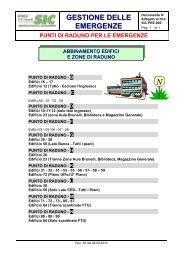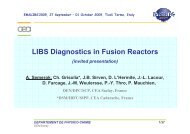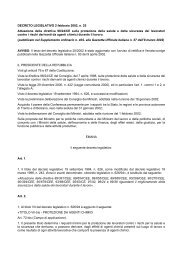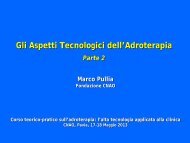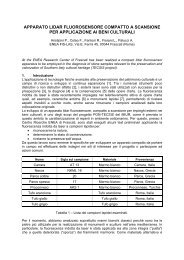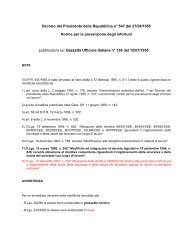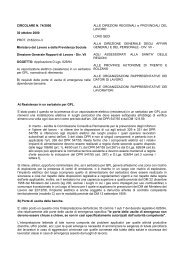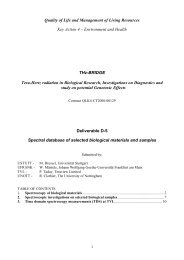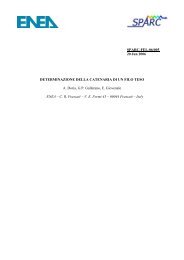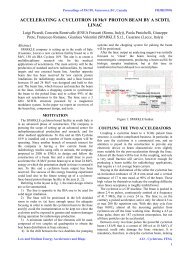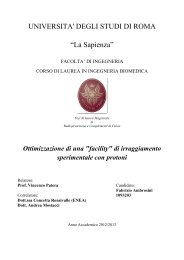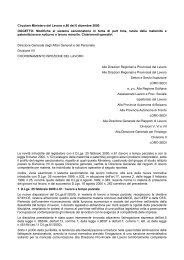Theory, Design and Tests on a Prototype Module of a Compact ...
Theory, Design and Tests on a Prototype Module of a Compact ...
Theory, Design and Tests on a Prototype Module of a Compact ...
You also want an ePaper? Increase the reach of your titles
YUMPU automatically turns print PDFs into web optimized ePapers that Google loves.
5. COUPLING BETWEEN WAVEGUIDE AND BRIDGE COUPLER 37<br />
• Since the coupling factor does not strictly depend <strong>on</strong> the res<strong>on</strong>ant<br />
frequency <strong>of</strong> cavities, <strong>on</strong>e can start studying the definiti<strong>on</strong><br />
<strong>of</strong> the correct coupling factor changing the dimensi<strong>on</strong>s (radii,<br />
length <str<strong>on</strong>g>and</str<strong>on</strong>g> positi<strong>on</strong>) <strong>of</strong> slots.<br />
• After this operati<strong>on</strong>, <strong>on</strong>e can operate again <strong>on</strong> the nose lengths<br />
to readjust the res<strong>on</strong>ant frequency to the correct value.<br />
We chose also movable inductive tuners in the bridge couplers cells with<br />
a big range <strong>of</strong> correcti<strong>on</strong> in order to prevent the error <strong>of</strong> simulati<strong>on</strong><br />
<strong>of</strong> MAFIA code which is about 10 MHz for our structure 8 . For the<br />
simulati<strong>on</strong>s, the tuners was c<strong>on</strong>sidered in their middle positi<strong>on</strong> in order<br />
to have positive <str<strong>on</strong>g>and</str<strong>on</strong>g> negative change <strong>of</strong> frequency. The range <strong>of</strong> these<br />
tuners was established by calculati<strong>on</strong> <strong>of</strong> the beginning <strong>of</strong> a capacitive<br />
effect (decrease <strong>of</strong> frequency).<br />
5. Coupling between Waveguide <str<strong>on</strong>g>and</str<strong>on</strong>g> Bridge Coupler<br />
In this secti<strong>on</strong>, we show a method which uses MAFIA <str<strong>on</strong>g>and</str<strong>on</strong>g> some<br />
other tools to determine the correct coupling between the waveguide<br />
<str<strong>on</strong>g>and</str<strong>on</strong>g> the bridge coupler in the LIBO module.<br />
Correct coupling means that the feeding waveguide is matched to its<br />
characteristic impedance Z0, <str<strong>on</strong>g>and</str<strong>on</strong>g> therefore there is no power reflected<br />
back to the klystr<strong>on</strong>.<br />
The figure <strong>of</strong> merit to quantify this c<strong>on</strong>cept is the coupling factor<br />
β, which is the cavity impedance, normalized to Z0 that the waveguide<br />
sees through the coupling mechanism, namely the iris.<br />
Then, β = 1 means perfect matching, β > 1 means that the module<br />
is overcoupled, <str<strong>on</strong>g>and</str<strong>on</strong>g> finally, β < 1 means that the module is undercoupled.<br />
The goal is to translate the c<strong>on</strong>diti<strong>on</strong> <strong>of</strong> perfect matching in the<br />
better dimensi<strong>on</strong>s <strong>of</strong> the iris, <str<strong>on</strong>g>and</str<strong>on</strong>g> <strong>of</strong> course the perfect matching is<br />
unfeasible; in this case it would be better to be slightly overcoupled.<br />
The idea <strong>of</strong> this method is to use MAFIA to measure the electric<br />
reactance <strong>of</strong> the cavity seen by the waveguide through the iris in the<br />
fundamental mode TE10 in a similar way as bridges are used for measurement:<br />
the unknown is given from a balance <strong>of</strong> reactances.<br />
The parameters to choose are the iris dimensi<strong>on</strong>s (width, length<br />
<str<strong>on</strong>g>and</str<strong>on</strong>g> depth) <str<strong>on</strong>g>and</str<strong>on</strong>g> the length <strong>of</strong> a short-circuited waveguide (see figure<br />
3.11).<br />
Note that the cavity is magnetically coupled to the waveguide, since<br />
the iris is located <strong>on</strong> the short side <strong>of</strong> the waveguide secti<strong>on</strong>. The fundamental<br />
mode TE10 has the maximum <strong>of</strong> the l<strong>on</strong>gitudinal comp<strong>on</strong>ent <strong>of</strong><br />
the magnetic field there. Therefore, it is better to put a short-circuited<br />
8 This error in the computati<strong>on</strong> was estimated comparing the RF measurement<br />
made in the microwave laboratory <strong>of</strong> INFN Sez. di Napoli with the results <strong>of</strong> the<br />
same structure simulated with MAFIA.



